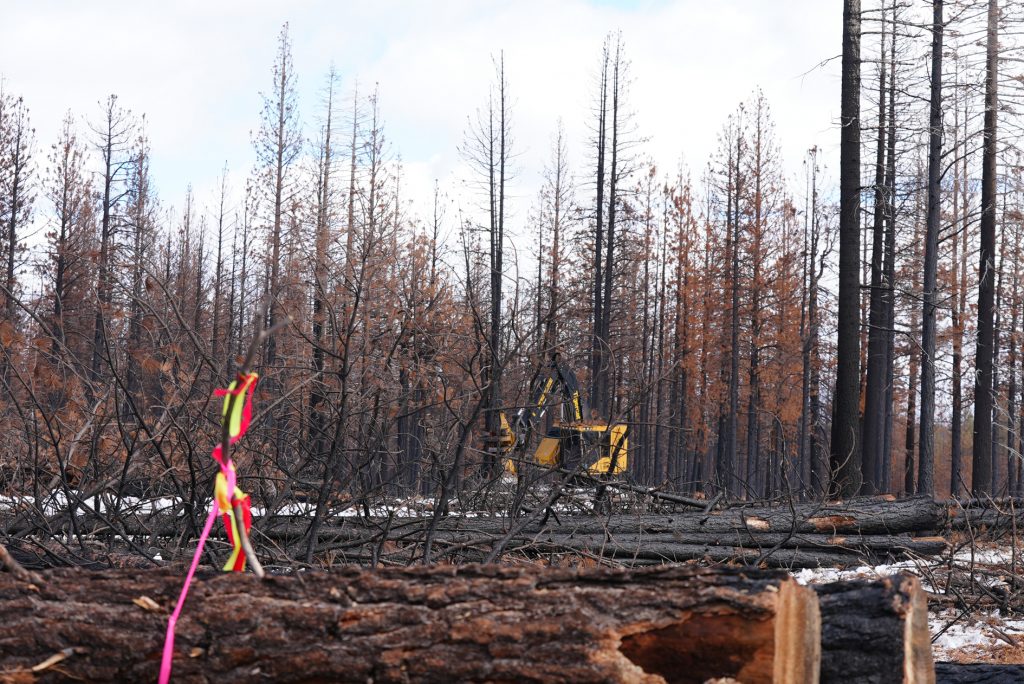Revival of the Colt Timber Sale – Saving the Klamath
This is Forest Supervisor Rachel Smith’s firsthand account of the Antelope Fire and its aftermath.
It was 97 degrees at 10 p.m. on the night Six Shooter Pass burned in 2021, and the battered old Forest Service sedan I was sitting in was struggling. Ash and billowing dust had choked the air intake. Cabin air vents emitted a thin stream of hot air at our faces.
The fire activity that Labor Day weekend seemed unreal. Even from a safe distance, I could feel the heat of the fire pressing against the windshield as we loaded up, traveling to the Incident Command Post for a briefing.
For our fire-weary state, the Antelope Fire couldn’t have ignited at a worse time. The focus of emergency resources around the West was on the Dixie and Caldor fires to our south, which had swallowed entire communities and threatened hundreds of thousands in central California.

Every unit that could be spared was headed our way, to Siskiyou County where we were battling dozens of wildfires. The help couldn’t come soon enough for the Klamath National Forest and our partners, fighting to protect rural communities and precious public and private lands. August’s grim fire campaign had spared the isolated town of Tennant from major loss and brought the Antelope Fire’s progression to a standstill.
But extreme red flag conditions — warm temperatures, low humidities, and stronger winds — drove explosive fire growth over Labor Day weekend. Overnight, the fire perimeter nearly doubled, then advanced again.
On a desolate road at the north end of the fire, a rolled-over water tanker trapped the driver. Forest Service and Bureau of Land Management law enforcement officers extracted him from the cab with Pulaski axes and ratchet straps. With the inescapable smoke and roiling dust, the only option for the volunteer firefighters from the tiny community of Dorris was to rush him to the hospital in their ambulance.
In the end, the loss of the Colt Timber Sale, one of four timber projects located in and around Six Shooter Pass, was just a footnote in the blaze that claimed 24 structures, injured four firefighters, and burned 150,000 acres.
A year after the fire, loss compounded loss when the buyers of the Colt Timber Sale cancelled their purchase. With living, green trees and timber prices soaring across the US, the 3,800-acre thinning project commanded a high price. But burned trees were another story.
In the months after the fire, charred logs had accumulated at the few remaining local mills — burned trees stacked into towering decks. Our local mills had limited capacity to accept blackened trees, and our local timber industry was at capacity dealing with their own burned trees. The Northern California market for burned logs was saturated.
Adding to the hardship, bark beetles were coming. Burned trees left standing after catastrophic fires even more recent than the Antelope fire were decaying rapidly. With each day, their insect-attacked value on the market dropped. And their financial worth wasn’t the only thing eroding.
As the trees deteriorated, entire stands were becoming more unstable. At some point, it would become too dangerous to work in the burned areas — charred snags would pose a threat to forest employees and the public.
But doing nothing on these burned landscapes was not an option. We were running out of time.
Snow squeaks under our boots as we step off the road. It’s been 18 months since we saved Tennant in a desperate 18-hour firefight, with logging equipment cutting fire breaks for 1950s water trucks. Fifteen months since we flew the injured equipment operator home to his wife and twin granddaughters. Nine months since the Colt Timber Sale was canceled, the trees left to decay on the landscape.
Yet forests are peaceful but never quiet. And this stand of trees, running along a road leading to rural ranches, a winter Sno-Park, and farms growing strawberries and mint for tea, is alive with activity. Even during the winter, beetle activity is evident on the blackened timber.
Beside me are representatives from the National Wild Turkey Federation and the California Deer Association. The National Wild Turkey Federation, one of the original conservation organizations, has agreed to take on the Colt Timber Sale. They will work with the California Deer Association to remove a portion of the trees on the landscape, thinning the stand to reduce the risk of future fires. They will help us mow and grind up shrubs, including juniper which has invaded this part of the state, using a patchwork of treatments.

And rather than adding to the existing backup at our local mills, many of the trees removed here will be transported via rail to small family timber mills in Wyoming and South Dakota.
The dead trees of the Colt Timber Sale sigh and groan in the light breeze. They are just a sliver of the public lands that need restoration but a significant step towards our long-term needs, for active management of our wildfire-prone forests and communities.
Rachel Smith is Forest Supervisor on the Klamath National Forest and Butte Valley National Grasslands, since 2020. Smith began her USDA Forest Service career in the 1990s as a hotshot in Region 6, then as a smokejumper in Region 5. She’s served in a variety of leadership roles, ranging from District Ranger in Texas to Deputy Regional Fire Director in Regions 6, 8 and 10. Smith holds a Ph.D. in Natural Resources Management from U.C. Berkeley.
CONNECT WITH US
National Wild Turkey Federation
770 Augusta Road, Edgefield, SC 29824
(800) 843-6983
National Wild Turkey Federation. All rights reserved.
